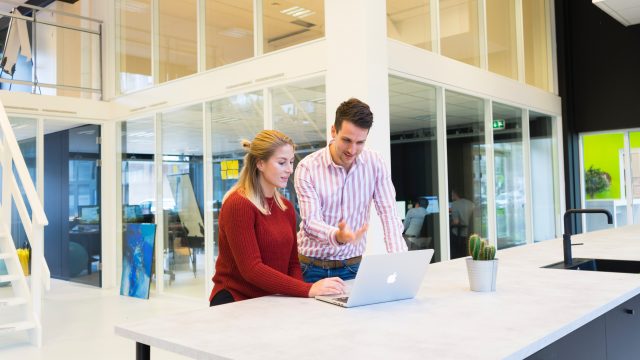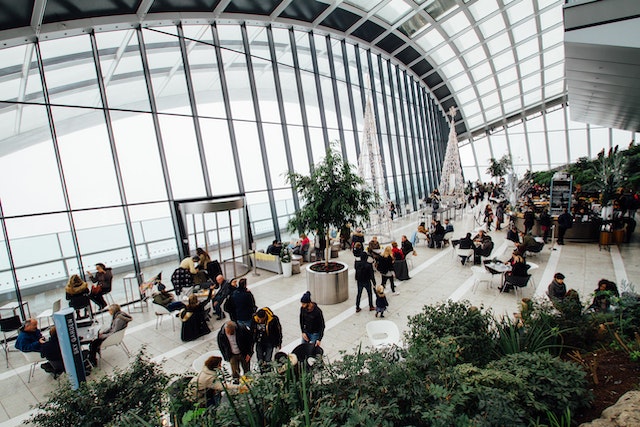Office Amenities of the Future: Office Building Facilities & Amenities to Look Out For
A return to the office is a reality in most US markets, but in 2023 work-from-home models are still common, since 27% of US office employees currently work from home. Not only that, but when surveyed, nearly 70% of US employees said they would prefer to work from home.
This raises an important issue for office facility managers: how to make in-person office work as attractive as the allure of the home office. In turn, this brings landlords into the equation, as they need to make their real estate offerings more competitive in a market where tenant demands have changed. In this article, we discuss the latest trends in office facilities and the best office amenities that can be found in 2023.

Contents
Latest trends in office facilities
Outdoor space
Although office work has traditionally been confined to indoor spaces, the renewed focus on air quality and overall well-being during the pandemic has brought to light the crucial role outdoor spaces play in modern corporate buildings. Research shows that access to nature and outdoor environments can improve productivity, reduce stress, and enhance creativity among employees.
Patios, rooftop decks, landscaped terraces, and other outdoor areas are rapidly becoming some of the most sought-after amenities for office workers. These physical spaces not only provide a breath of fresh air and an escape from the indoor office environment, but also foster social interactions and collaboration among employees, creating a healthier and more dynamic workplace culture.
Furthermore, these outdoor spaces can be utilized for various purposes such as hosting corporate events, casual meetings, and team-building activities. Companies are increasingly investing in amenities like comfortable seating, Wi-Fi connectivity, and even outdoor cafés or dining areas to make these spaces more versatile and attractive to potential tenants.
As the demand for outdoor spaces continues to grow, it is essential for office providers to consider integrating green areas and open-air facilities into their commercial building designs. This allows them to stay competitive in the market and appeal to a wide range of potential clients looking for green space for executive offices and shared workspaces.
De-densified office space
The fusion of easily accessible outdoor spaces and de-densified indoor work areas has emerged as an effective way to enhance well-being and productivity in office environments. De-densification, which refers to increasing the amount of square footage per employee, was initially a response to social distancing guidelines during the pandemic. However, it has since become apparent that this approach offers numerous benefits in its own right.
After experiencing work-from-home arrangements, many office workers have come to appreciate the value of personal space in boosting concentration and productivity, as opposed to working in crowded offices. This new preference has driven the demand for de-densified office spaces, making it a critical consideration for office providers looking to attract and retain tenants.
There are various strategies that can be employed to achieve a less densely occupied office, including:
- Setting up satellite offices: This approach involves establishing smaller, geographically dispersed offices to reduce the number of employees working in one central location. This not only reduces office density, but also minimizes commute times and offers employees more flexibility.
- Staggering work schedules: Adjusting work schedules so that employees have staggered attendance can help maintain a lower density in the office. This can be achieved through flexible hours, split shifts, or alternating remote and in-office workdays.
- Rearranging office furniture and decluttering: Creating a more spacious layout by reorganizing office furniture and removing unnecessary items can make a significant difference in the perception of space. Incorporating modular and flexible furniture can further enhance the adaptability of the workspace to cater to employees’ needs.
- Implementing activity-based working (ABW) environments: ABW is a workplace strategy that provides a variety of spaces tailored to different tasks and working styles, rather than assigning each employee a dedicated workstation. This approach can help optimize the use of space while promoting employee well-being and productivity, all whilst having a profoundly positive impact on a company’s culture.
As the trend towards de-densified office spaces continues to gain momentum, office providers need to stay ahead by offering flexible and innovative solutions that cater to the evolving preferences and needs of their clients.

Dedicated relaxation areas
Today’s office spaces should consist of more than just reception and workspace. The concept of dedicated relaxation areas, or “recharge rooms,” has emerged as a top trend set to revolutionize the office environment. Studies have demonstrated that a balanced work-life dynamic is essential for maintaining productivity and staff morale. Providing spaces for employees to unwind and recharge is a vital component of this balance.
Dedicated relaxation areas go beyond the typical breakout rooms found in many office buildings. These spaces are specifically designed to help employees temporarily disconnect from the work environment and alleviate stress, allowing them to return to their tasks with renewed energy and a positive outlook. By investing in such amenities as wellness rooms, companies can foster a healthier, more supportive work atmosphere that contributes to employee satisfaction and retention.
Some popular relaxation facilities include:
- Tech-free rooms: These spaces are free from computers, phones, and other electronic devices, promoting a quiet and peaceful atmosphere where employees can focus on relaxation, reading, or other non-work-related activities.
- Nap pods or quiet rooms: These are designated spaces with comfortable seating or sleeping arrangements for employees who are working long hours or experiencing sleep deprivation. Research shows that short naps can improve alertness and cognitive performance, making these rooms a valuable addition to the modern workplace.
- Yoga and meditation areas: Mindfulness practices such as yoga and meditation have been shown to reduce stress, improve focus, and boost overall well-being. Providing dedicated spaces for these activities allows employees to incorporate them into their daily routines, promoting a healthier work-life balance.
- Game rooms or recreational spaces: Having areas designated for games or recreational activities can also help employees unwind, socialize, and recharge. These spaces can feature table games, video games, or even a small library or reading nook.
As the trend towards dedicated relaxation areas in office spaces continues to grow, it’s essential for office providers to consider incorporating these amenities into their offerings. By doing so, they can create a more attractive, supportive, and productive work environment that meets the evolving wellness needs of their clients.
Sustainability by design
Creating environmentally friendly workspaces that promote health and well-being is becoming a non-negotiable aspect of modern office design. In response to the increasing demand for sustainable practices, office providers are integrating eco-conscious elements into their spaces, making sustainability by design one of the most sought-after amenities today.
The most successful strategies for creating sustainable office spaces include:
- Minimizing waste: Implementing recycling and composting programs, encouraging reusable items, and reducing single-use products can significantly decrease the amount of waste generated by an office. Additionally, digitalization and paperless solutions can further reduce the environmental footprint of a workspace.
- Reducing reliance on non-renewable resources: Integrating renewable energy sources, such as solar panels or wind turbines, can help decrease an office building’s dependence on non-renewable resources. This not only lowers the environmental impact, but can also lead to long-term cost savings on energy bills.
- Smart water management: Efficient water usage can be promoted through the installation of low-flow fixtures, rainwater harvesting systems, and drought-resistant landscaping. These measures help conserve water resources while reducing utility expenses.
- Improving energy efficiency: Implementing energy-efficient features, such as LED lighting, smart thermostats, and energy management systems, can dramatically decrease a building’s energy consumption. High-performance windows and insulation materials can also contribute to improved thermal comfort and energy efficiency. It should also be noted that natural light is a large draw card for a lot of prospective employees, making naturally lit areas both energy efficient and attractive to employees.
- Using sustainable office supplies and furniture: Choosing office furniture and supplies made from recycled or sustainably sourced materials, or with eco-friendly manufacturing processes, can further reduce the environmental impact of a workspace. Additionally, opting for modular and adaptable furniture can extend its lifespan and minimize waste generated by frequent replacements.
- Incorporating biophilic design elements: Integrating natural elements, such as plants, natural materials, and natural lighting, can not only enhance the aesthetics of a space but also contribute to improved air quality and employee well-being.
As the trend towards sustainability by design continues to gain momentum, it is crucial for office providers to adopt eco-conscious design principles and practices. Doing so will not only create more attractive and healthier work environments but also appeal to a growing number of potential clients who prioritize environmental responsibility in their workspace choices.

Adaptive reuse of parking space
In urban environments, the availability of parking is a big issue, especially for large companies or those in centrally located areas. Given the anticipated changes in the area of transportation, for example the development of driverless vehicles or the widespread adoption of car sharing, many employers and landlords are reconsidering their current use of parking space.
The main trend here is towards adaptable office car park areas, designed or redesigned leaving leeway for future changes, and ensuring suitability for alternative uses.
Due to the permanent implementation of remote and hybrid work and the availability of alternative means of transport, many office parking lots will end up with unused space. This is why we’re seeing repurposed parking space in many CBDs, turned into pedestrian or open space for tenant use, or incorporating commercial additions where mixed-use developments are possible.
The human-centric approach to workplace amenities
Human-centric approaches involve planning and designing office space and amenities taking into account the needs and preferences of staff. This means privileging experience over function, without neglecting the latter.
Human-centric workspaces make the work day more enjoyable for staff, so they’re motivated to do their best. Here are some strategies to implement a human-centric approach to office amenities:
- Using activity-based layouts that account for meetings, focused work, quiet time, socializing, and any other task performed during a typical work day.
- Organizing regular well-being workshops, where experts discuss strategies to help employees cope with stress, burnout, improve eating and sleeping habits, etc.
- Human-centric office furnishings, chosen for their ability to deliver a pleasant and comfortable experience, like biophilic additions, acoustic furniture, standing desks, living walls, ping pong tables, a mix of private and collaborative furniture, etc.

Other amenities to incentivize tenants and employees
According to a recent survey, the most effective amenities used to incentivize office tenants and employees are:
- Hybrid work (80%)
- Changes to space and layout (61%)
- A flexible attendance policy (5%)
- Also scoring high were amenity upgrades like lounges, fitness facilities, outdoor space, on-site restaurants and bicycle storage.
Integrated smart tech is another element to consider. The switch to remote work has uncovered inefficiencies in the use of technology, especially where piecemeal approaches were used. This is why office employees increasingly understand the value of integrated technology, as it helps make their work easier and more efficient.
Popular integrated tech additions include:
- App-based attendance registers
- Automated room and desk booking systems
- Tenant apps featuring healthy in-app food service ordering options
Lastly, the rapid development of AI has left many office employees wondering how best use it to be more productive. As part of an attractive and upgraded amenities package, it’s worth considering the inclusion of this technology and adequate training that allows staff to focus on the task at hand, while reducing the time they spend on repetitive tasks. Increasingly, businesses are looking for office perks that make employees feel as if they are a larger part of their overall office culture. These AI tools driven by the digital age take time away from menial tasks and provides businesses with more time to promote employee engagement initiatives.
Looking to rent an office building facility? Offices.net can help!
Looking for a new office space? Offices.net currently lists an extensive range of workspaces, appealing to everyone from major multinational corporations to small startups. Contact us today or view our full range of executive offices and shared workspaces today! Notable locations include New York City, Houston, Chicago, and San Francisco.